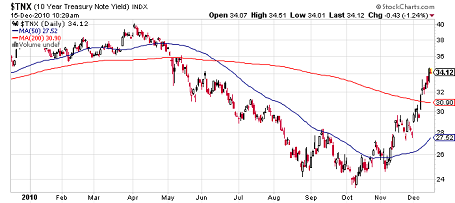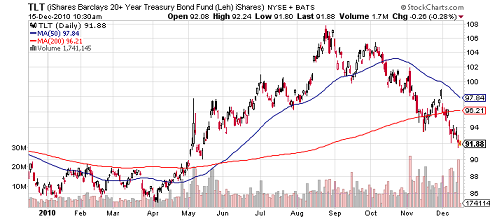We’ve talked in the past about trades that are too
one-sided. We’ve seen the U.S. dollar rally when everyone was looking for
it to collapse. We’ve seen housing stocks rally in a dead housing
market.
And most recently, we’ve seen bond yields rally in
the face of a Fed policy that was supposed to keep yields
contained.
Are we seeing the market repudiate the Fed’s
Treasury buying program? Are higher yields a statement that inflation is
on the way?
There are plenty of analysts and economists that
think QE2 is a bad idea. I’ve been one of them.
And even now, as economic data improves to the point
that GDP forecasts are moving higher, the Fed appears steadfast that the
economy needs more stimulus. The language in yesterday’s FOMC statement
was unchanged.
The inflationary risks of QE2 have been well
articulated by the anti-Fed crowd. And even though today’s CPI number
shows that inflation is not happening, it’s easy to interpret the rise in
bond yields as sign that inflation is right around the corner.
If employment picks up, inflation may become a risk.
But until that happens, there’s another way to interpret the rise in bond
yields: maybe yields are rising simply because investors are selling
bonds

Here’s a one-year chart that shows the yield of the
10-year Treasury. It’s made a big move since early November. But let’s
look at the action for the 20+ Treasury bond ETF, TLT.

It’s pretty hard to miss the huge volume surge that
started in November, when the Fed actually announced its QE2
plans.
At its most simple level, a market is made of buyers
and sellers. When there are more sellers, prices fall. In the case of
bonds, more sellers means prices fall and yields rise. Maybe this is a
good time to think of bonds in terms of buyers and sellers, rather than
inflation.
Here’s a headline from Seeking Alpha, a popular
investment website:
 Facebook
Facebook
 Twitter
Twitter